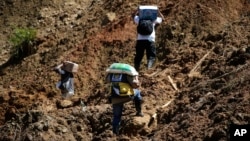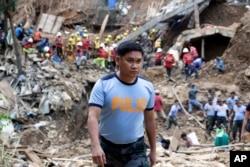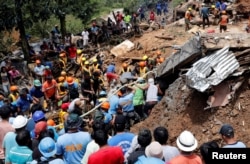They're eerie photographs, probably the final images of a few Filipino villagers standing placidly outside low-slung buildings a day before the green mountainside behind them collapsed on that spot. The massive landslide buried dozens of poor miners and their families as Typhoon Mangkhut rampaged across the country's north.
A flimsy umbrella held over his head, a village leader is talking to police officers, who are wearing hard hats, boots and raincoats in the photographs obtained by The Associated Press from the Philippine police.
Senior Inspector Heherson Zambale, who is seen in the photographs, told the AP that he and other officials were trying to persuade village leader Edwin Banawol to evacuate the high-risk mountainside area on Friday with dozens of mostly small-scale gold miners and their families. The authorities worried about the approach of the powerful typhoon. Banawol and the other villagers refused.
Banawol's body was among more than a dozen dug up by rescuers from the avalanche of mud and earth in Itogon in Benguet province. More than 50 are missing, Zambale said.
It was one of the worst calamities to hit the disaster-prone Philippines this year and refocused attention on a persistent dilemma: What to do about the large number of poor who live and work on or near steep mountains, volcanoes, earthquake faults and storm-vulnerable coastlines out of desperation?
"Poverty should not be a hindrance for people not to know and for them not to act," said Renato Solidum, a senior government official who has done extensive studies on natural disasters and ways to minimize risks.
He said Wednesday that local officials could decide on the best steps to take if signs point to an imminent peril and people remain unperturbed.
While the Philippines has made headway in mapping natural hazards, information about dangers in specific areas could be made more accessible, Solidum said, citing a proposed project called "Hazard Hunter," which informs residents about the natural perils in their community on their cellphones.
Environmental Secretary Roy Cimatu ordered all small-scale mining in Benguet and outlying provinces stopped indefinitely following the disaster in Itogon, where people had gone to mine gold and settled in perilous mountainside shantytowns.
Miner Fidel Ngipol said he understood that mining is dangerous, but that the government should help thousands of poor miners find livelihoods. "This is lucrative, even if it's hard, but when we earn, it's enough and can sustain our family," Ngipol said.
Itogon Mayor Victorio Palangdan told reporters he had ordered the evacuation of residents but some, including the villagers who sought refuge in the chapel and bunkhouses, refused. Some even laughed at police officers and told them their shelter was safe, he said.
Forcibly removing people from their homes could open government forces to human rights complaints, said Palangdan.
Mangkhut left at least 81 people dead with 70 others missing in the Philippines, police said. Most of those occurred in Benguet and outlying mountain provinces, where about 100 landslides were recorded, with the avalanche in Itogon the largest and deadliest.










